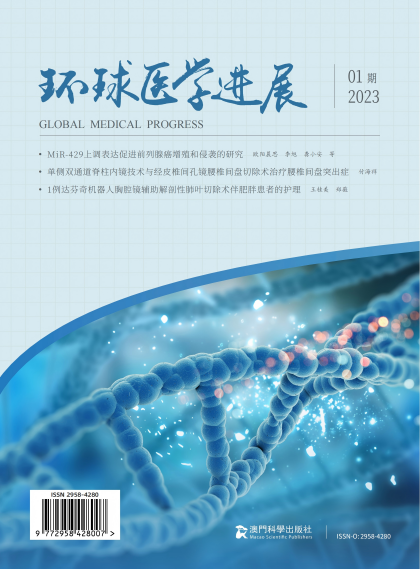
The Infection Characteristics and Treatment Progress of Neurosyphilis in The Aids Population
何小清, 沈银忠, 张仁芳, 等. 未启动抗反转录病毒治疗的人类免疫缺陷病毒/艾滋病患者发生心血管疾病的风险评估[J]. 中华传染病杂志, 2020, 38(10): 640-645.
UNAIS. UNAIDS data 2019[EB/OL]. [2019-10-30]. https://www.unaids.org/siteDs/default/files/media_asset/2019-UNAIDSdata_en.pdf.
国家卫生健康委员会. 2019 年我国艾滋病防治工作取得新进展[EB/OL]. [2019-11-30](2020-12-30).http://www.nhc.gov.n/jkj/s3586/201911/c2388ce70bdd404ea6dfcd886591784d. shtml.
吴肖冰, 冯铁建, 余卫业. 预防控制梅毒母婴传播的关键措施及实施效果[J/CD]. 新发传染病电子杂志, 2019, 4(4): 204-208.
ROPPER AH. Neurosyphilis[J].The New England Journal of Medicine, 2019, 381(14): 1358-1363.
GONZALEZ H, KORALNIK IJ, MARRA CM. Neurosyphilis[J]. Seminars in Neurology, 2019, 39(4): 448-455.
卢改会, 普雄明. 血清 RPR 滴度与神经梅毒相关性分析[J]. 中国麻风皮肤病杂志, 2017, 33(10): 577-579.
中国卫生健康委员. 2021 年全国法定传染病疫情概况[EB/ OL]. (2022-04-22)[2022-06-27].http://www.nhc.gov.cn/cms-search/xxgk/getManuscriptXx.htm?id=4fd88a291d914abf8f7a9lf6 333567e1.
傅天颖, 吴昊澄, 鲁琴宝, 等. 2021 年浙江省法定传染病疫情分析[J] 预防医学, 2022,(8): 34.
Raynell L, Ron R, Hartmut BK, et al. Increasing incidence of syphilis among patients engaged in HIV care in Alberta,Canada:aretrospective clinic-based cohort study[J]. BMC Infectious Diseases, 2018, 18(1):125.
Salado R, Maria W, Susan AC, et al. Syphilitic hepatitis and neurosyphilis: an observational study of Danish HIVinfected individuals during a 13-year period[J]. Sexually Transmitted Infections, 2019, 95(6): 416-418.
陈世海, 杨晓钊, 李浩, 等. 我国老年人艾滋病和梅毒感染及知识行为现状[J]. 职业与健康, 2015, 31(2): 272-275.
HESSOU PHS, YOIAINE GA, RHEDA A, et al. Comparison of tlle prevalence rates of HIV infection between men who have sex withmen(MSM) and men in the general populationin sub—Saha-ran Africaca:a systematic review and meta-analysis[J/0L]. BMC Public Health, 2019, 19.
朱文利, 徐建慧, 徐宇浩, 等. 以全面性强直—阵挛发作为首发症状神经梅毒误诊原因分析[J]. 临床误诊误治, 2022, 35(05): 1-4.
唐欷柯, 彭智鹏, 梁联哨, 等. 艾滋病合并神经梅毒感染的最新研究进展[J]. 新发传染病电子杂志, 2020, 5(03): 203-206.
郑方, 高丹红, 沈银忠, 等. 上海市某医院艾滋病合并梅毒病例特征分析及影响因素探讨[J]. 微生物与感染, 2022, 17(01): 30-34.
Lynn WA, Lightman S. Syphilis and HIV:a dangerous combination[J]. The Lancet Infectious Diseases, 2004, 4(7): 456-466.
汤小琳, 梁铭, 曹存巍, 等. 早期梅毒患者血清甲苯胺红不加热血清试验滴度与神经梅毒发生的相关性分析[J]. 中国性科学, 2022, 31(06): 137-140.
Khalil GG, Richard DM, Anne MR, et al.Neurosyphilis in aclinical cohort of HIV-1-infected patients[J]. AIDS, 2008(22): 1145-1151.
Gonzalez H, Koralnik IJ, Marra CM. Neurosyphilis[J]. Seminars in Neurology, 2019,39(4): 448-455.
王倬, 吴洵昳, 王蓓, 等. 神经梅毒 60 例临床表现分析及诊治体会[J]. 中国性科学, 2015,4: 1-6.
Wang ZY, Liu L, Shen YZ, et al. The clinical and laboratory features of neurosyphilis in HIV-infected patients A retrospective study in 92 patients[J]. Medicine, 2018,97(9): 1-9.
李琳, 王佳伟. 梅毒性视神经炎 12 例临床分析[J]. 中国现代神经疾病杂志, 2016, 16(7): 416-423.
朱健. 78 例神经梅毒患者临床分析[D]. 安徽医科大学, 2021.
谭小林, 杜东平. HIV 阴性的神经梅毒临床诊治分析[J]. 检验医学与临床, 2017, 14(3): 375-377.
中国疾病预防控制中心性病控制中心, 中华医学会皮肤性病学分会性病学组, 中国医师协会皮肤科医师分会性病亚专业委员会. 梅毒、淋病和生殖道沙眼衣原体感染诊疗指南(2020 年)[J]. 中华皮肤科杂志, 2020, 53: 168-179.
丁斯博. 水剂青霉素治疗神经梅毒前后脑脊液的临床分析[J]. 当代医学, 2019, 25(8): 134-136.
刘经纬, 徐文绮, 尹跃平. 梅毒实验室检测技术及策略的进展[J]. 中国艾滋病性病. 2021,27(03): 323-326
高岩, 崔元斌, 龚一谦, 等. HIV 感染者/AIDS 病人抗病毒治疗服药依从性管理相关循证指南的质量评价[J]. 护理研究, 2020, 34(3): 414-419.
中华医学会感染病学分会艾滋病丙型肝炎学组, 中国疾病预防控制中心. 中国艾滋病诊疗指南(2018 版)[J]. 新发传染病电子杂志, 2019,4(2): 65-84.
冷欣颖, 邹华春, 付雷雯, 等. 2021 年美国CDC 梅毒诊疗指南注意事项读解[J]. 皮肤性病诊疗学杂志, 2022, 29(1): 57-63.
孙杰, 李爱莉, 袁阳. 苄星青霉素驱梅治疗后无症状神经梅毒发病情况的临床分析[J]. 实用皮肤病学杂志, 2018, 11(1): 20-22.
Shenoy ES, Macy E, Rowe T, et al. Evaluation and management of penicillin allergy:a review[J]. JAMA: the Journal of the American Medical Association, 2019, 321(2): 188-199.
Buitrago-Garcia Diana, Martí-Carvajal Arturo J, Jimenez Adriana, et al. Antibiotictherapy for adults with neurosyphilis[J].The Cochrane Database of Systematic Reviews, 2019, 5.
栾兴宝, 黄晓婕, 高艳青. 非青霉素药物治疗合并 HIV 感染梅毒的研究进展[J]. 北京医学, 2022, 44(01): 71-73.
鞠小玲, 杜坤, 程丰, 等. 苄星青霉素联合头孢曲松钠对早期梅毒患者皮损及血液免疫指标的影响观察[J]. 中国性科学, 2015, (2): 53-56.
BAZEWICZ M, LHOIR S, MAKHOUL D, et al.Neurosyphilis cerebrospinal fluid findingsin patients with ocular syphilis[J]. Ocular Immunology and Inflammation, 2021, 29(1):95-101.
DAVIS JL. Ocular syphilis[J]. Curr Opin Ophthalmol, 2014, 25(6): 513-518.
王倬, 吴洵呋, 王蓓, 等. 神经梅毒 60 例临床表现分析及诊治体会[J]. 中国性科学, 2015,(4): 65-67.
靳西龙, 许秋霞, 郭玮刚, 等. 头孢曲松钠联合阿立哌唑治疗神经梅毒伴发精神症状的临床观察[J]. 中国药房, 2015, 26(15): 2087-2089.
Li J, Zheng HY. Early syphilis: serological treatment response to doxycycline/tetracycline versus benzathine penicillin[J]. Journal of Infection in Developing Countries, 2014, 8(2): 228-232.
Xiao H, Liu D, Li Z, et al. Comparisonof doxycycline and benzathine penicillin G for the treatment of early syphilis[J]. Acta Dermatovenerologica Croatica : ADC, 2017,25: 107-111.
Girometti N, Junejo MH, Nugent D, et al. Clinical and serological outcomes in patients treated with oral doxycycline for early neurosyphilis[J]. The Journal of Antimicrobial Chemotherapy, 2021, 76(7): 1916-1919.
周孔香. 米诺环素与肌注苄星青霉素治疗梅毒对患者血清学指标及血清固定发生的影响[J]. 当代医学, 2019, 25(28): 175-176.
Janier M, Unemo M, Dupin N, et al. 2020European guideline on the management of syphilis[J]. Journal of the European Academy of Dermatology and Venereology : JEADV, 2021, 35(3): 574-588.
Zhang RL, Wang QQ, Zheng ZJ, et al. Relationship between the high frequency of 23S rRNA point mutations in Treponema pallidum and low serological response rate to azithromycin treatment in China[J]. Inertnational Journal of Dermatology and Venereology, 2019, 2(1): 6-14.
Fernández-Naval C, Arando M, Espasa M, et al. Enhanced molecular typing and macrolide and tetracycline - resistance mutations of Treponema pallidum in Barcelona[J]. Future Microbiology, 2019, 14: 1099-1108.
Tsai MS, Yang CJ, Lee NY, et al. Jarisch-Herxheimer reaction among HIV- positive patients with early syphilis: azithromycin versus benzathine penicillin G therapy[J]. Journal of the International AIDS Society, 2014, 17(1): 18993.
林丹红, 李淑莲, 林惠玲, 等. 梅毒血清反应素滴度在神经梅毒腰穿指征中的作用[J]. 中国皮肤性病学杂志, 2017, 31(09): 994-997.
王娟娟. 以精神行为异常为首发症状的神经梅毒细胞因子检测和分析[D]. 苏州大学, 2020.